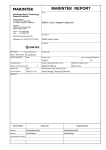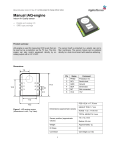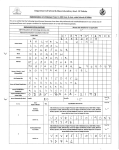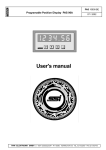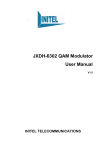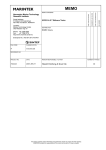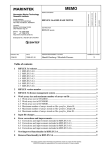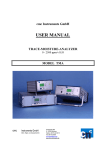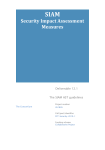Download SIMO - User`s Manual – Appendix B Version 3.2
Transcript
SIMO – User’s Manual Appendix B – MAIS – Use of application programs V. 3.4 / June 2004 APPENDIX B MAIS – Use of application programs 2001-516412-01131501 / Page B1 of B12 SIMO – User’s Manual Appendix B – MAIS – Use of application programs V. 3.4 / June 2004 CONTENTS B1. INPUT TYPES ....................................................................................................................... 3 B1.1 Parameter input ......................................................................................................... 3 B1.2 Integer array input..................................................................................................... 4 B1.3 Selection of options from a menu ............................................................................. 4 B1.4 Yes/no question ........................................................................................................ 5 B1.5 Text input.................................................................................................................. 5 B1.6 Program pause .......................................................................................................... 6 B2. MACRO SYSTEM ................................................................................................................ 7 B2.1 Macro commands...................................................................................................... 7 B2.2 Macro file description............................................................................................... 8 B2.3 Generating a macro file interactively........................................................................ 9 B2.3.1 Parameter input ................................................................................................. 9 B2.3.2 Integer array input ........................................................................................... 10 B2.3.3 Menu input ...................................................................................................... 10 B2.3.4 Yes/no input .................................................................................................... 10 B2.3.5 Text input ........................................................................................................ 11 B2.3.6 Program pause ................................................................................................. 11 B2.4 Reading from macro file ......................................................................................... 11 2001-516412-01131501 / Page B2 of B12 SIMO – User’s Manual Appendix B – MAIS – Use of application programs V. 3.4 / June 2004 B1. INPUT TYPES B1.1 Parameter input The parameters to a command may be of different types (character, real, integer) and are normally given on a single line separated by spaces. Default values are obtained by slashes, “/”. If an incorrect number of parameters are given the program asks for each parameter. Default values are then obtained by giving “/” or by pressing <return>. All real and integer variables have a defined allowable range, and all variables have default values. If one of the parameters is outside the allowable range the program prompts for all parameters. Character parameters may only be single words, (maximum 16 characters). Example: The command “Modify vessel position” requires 3 real parameters: ”X – pos.”, “Y-pos.” Vessel position : 10. 5 30 Comment: The input was accepted Vessel position : ** WARNING ** 3 input parameters are required X – pos. (m) ( Y – pos. (m) ( Heading (deg) ( 10. 5 0.0 ) : 10 0.0 ) : 0.0 ) : 30 Comment: The program produces warnings if too few or too many input parameters are given. The only exception is when / is given as input to obtain the default values. See below. Vessel position : 13572 -62471 ** WARNING ** Allowable range of parameter 1 is (-9999. 9999 ** WARNING ** Allowable range of parameter 2 is (-9999. 9999 X – pos. (m) ( 0.0 ) : Y – pos. (m) ( 0.0 ) : Heading (deg) ( 0.0 ) : 30 ) ) 135.72 30 Note! Test on allowable range may be omitted by giving the macro command @RANGE OFF (see Section B2.1 of this appendix) 3 default values are obtained by typing 3 slashes separated by spaces. Vessel position : / / / 2001-516412-01131501 / Page B3 of B12 SIMO – User’s Manual Appendix B – MAIS – Use of application programs V. 3.4 / June 2004 B1.2 Integer array input An arbitrary number of integers up to a maximum number may be read. Any validation of the given parameters may be coded outside the MAIS routine. Example: Parameters to be plotted Max. 2 numbers : 1 2 B1.3 Selection of options from a menu Answers in menus can be given as: • • A number corresponding to the number in the option list Characters with lower-case or upper-case letters and with spaces before or after the text. The input string is first converted to an integer which is compared to the option list. If the conversion fails the text is split into words and the words are compared to the option texts. Examples: |-> | | | | | | |-> INPUT MODULE |-> | | | | | | |-> MAIN MENU 0 1 2 3 : : : : Return Read wind coefficients Read wave coefficients Read current coefficients Select option : 1 : Input module 2 : Static module 3 : Dynamic module 99 : Terminate Select option : Examples of answers: |-> |-> |-> |-> |-> |-> Select Select Select Select Select Select option option option option option option : : : : : : dYn d Yn d m 3 DYNAMISK Accepted Not accepted Accepted Not accepted Accepted Not accepted 2001-516412-01131501 / Page B4 of B12 SIMO – User’s Manual Appendix B – MAIS – Use of application programs V. 3.4 / June 2004 B1.4 Yes/no question The defualt answer is indicated behind the question. The program tests the first character different from ”space” in the input. The defualt value is obtained by giving ”/” or by pressing <return>. If the first letter is different from ”y”, ”Y”, ”n” or ”N” the question will be repeated. Example: Do you want to store the data ? (Y) : Comment: The default value here is YES. The followin input would be interpreted as NO: - n - no thanks B1.5 Text input NEI Text input may contain up to 70 characters in each line, any number of lines. In the example below 30 characters is used. The text can not start with @, *or ' in any line because these characters have a special meaning. If the user gives spaces or nothing the default character string is used. The string is cleared if ”>” is given. Example : Give 3 text lines -----------------------Old 1 (Run 1 ) Txt 1 : Run 4 Old 2 ( ) Txt 2 : 4-JUL-1988 Old 3 ( ) Txt 3 : Calculations performed by NN 2001-516412-01131501 / Page B5 of B12 SIMO – User’s Manual Appendix B – MAIS – Use of application programs V. 3.4 / June 2004 B1.6 Program pause A pause in the program may or may not be followed by the message : Press <return> to continue : The program resumes execution when the <return> key is struck. If the command @WAIT OFF (see chapter B2.1) has been given, the program will not make any pause. 2001-516412-01131501 / Page B6 of B12 SIMO – User’s Manual Appendix B – MAIS – Use of application programs V. 3.4 / June 2004 B2. MACRO SYSTEM B2.1 Macro commands Macro commands can be used anywhere where the program waits for input. The commands must contain enough characters so that they are unique. Can be stored in macro file (Y/N) @HELP Y Writes a list of all macro system commands with short explanations. @OPEN file N The command opens the given file for writing. All questions and answers until @CLOSE is given will be stored on the macro file. The fiie name is converted to uppercase, and suffix .MAC is added if "." is not in the file name. If the command is given a second time before @CLOSE, @DO file is stored at the macro file. @CLOSE N The command closes the file. Message is written at the screen. @DO finame <n> Y Input is read from specified file with name FINAME.MAC <n>times. If <n>is omitted the file is read once. In the command the file name can be written in uppercase and lowercase letters, with or without the extension. @LIST file N The content of the file is listed. @SPAWN N The program is set in a "waiting condition ". A new process is created. This means that all operating system commands can be given. Y Changes the program switch IWAIT to 1/0, respectively. IWAIT = 0 : pauses are not enabled IWAIT = 1 : enables pauses in the program execution. Such stops are normally followed by the message "Press <return> to continue". Y Changes the program switch IDISP which determines the @WAIT ON/OFF @DISP ON/OFF 2001-516412-01131501 / Page B7 of B12 SIMO – User’s Manual Appendix B – MAIS – Use of application programs V. 3.4 / June 2004 amount of output to screen when executing a macro file. IDISP=0: Only comment lines from the macro file are written on the screen IDISP = 1: All questions, answeres and comment lines are written on the screen when input is read from a macro file @RANGE ON/OFF Y Changes the program switch IRCK IRCK = 0: No check that input values are within allowable range IRCK = 1: (default) Check on allowable range is enabled @ STATUS Y Lists the values of the macro switches, and gives information about the macro files in use. * Y Marks that this parameter shall be read from the keyboard when input is read from a macro file. The effect of the last two program switches depends on the implementation of these in the application program: @FILE IFILE Y Changes the program switch IFILE. Allowable range is 0 – 5. The switch is returned to the calling routine to change the amount of results to the print file. @ RESULT IRESU Y Changes the program switch IRESU. Allowable range is 0-5. The switch is returned to the calling routine to change the amount of results shown at the screen B2.2 Macro file description A macro file is defined as an ascii file which contains input that can be read by the program. Comments (explaining text) may be stored in the file in addition to the program input. The macro file may consist of 2 types of lines. • • Comment lines are lines where “ ’ ” is the first nonblank character. Comment lines may be placed anywhere on the macro file. They are read and written on the screen when the macro file is used, but have no effect on the calculations. Input lines. An input line may also contain a comment field starting with “ ’ ”. Comment text which is located between the first and second occurrence of “ ’ ” is during execution checked against the prompt text normally shown on the screen. If inconsistency is found, a warning is 2001-516412-01131501 / Page B8 of B12 SIMO – User’s Manual Appendix B – MAIS – Use of application programs V. 3.4 / June 2004 displayed and the user is asked whether the next line on the file should be read or the macro file(s) should be closed. Some of the macro commands may be stored in a macro file. B2.3 Generating a macro file interactively After the command “@OPEN <file>” has been given, the user input will be logged at the file. Input that is not accepted by the program is not stored. If for instance an erroneous option is given in a menu, the menu will be displayed again and only the valid option will be stored at the macro file. B2.3.1 Parameter input Only input that is accepted by the program is stored at the macro file. Example : Vessel position : 10. 5. 30 Macro file : 10. 5. 30 ’Vessel position If a * is stored in the macro file then this parameter will always be read from the keyboard. Example : Vessel position X - pos. (m) Y - pos. (m) Y - pos. (m) Heading (deg) : ( ( ( ( 0.0 0.0 0.0 0.0 ) ) ) ) Macro file : ! 10. * 0. ’ Vessel position ’ X - pos. (m) ’ Y - pos. (m) ’ Heading (deg) 2001-516412-01131501 / Page B9 of B12 : 10. : * : 5. : SIMO – User’s Manual Appendix B – MAIS – Use of application programs V. 3.4 / June 2004 B2.3.2 Integer array input Example: Parameters to be plotted Max. 2 numbers : 1 2 Macro file: 1 2 B2.3.3 Menu input Example : |-> | | | | | | |-> MAIN MENU 1 2 3 99 : : : : Input module Static module Dynamic module Terminate Select option : DYNAMIC Macro file : ’ MAINMENU DYNAMIC B2.3.4 Yes/no input Example : Do you want to store the data ? (Y ): NO Macro file : NO ’ Do you want to store the data? 2001-516412-01131501 / Page B10 of B12 ( Y ) SIMO – User’s Manual Appendix B – MAIS – Use of application programs V. 3.4 / June 2004 B2.3.5 Text input Example : Give 3 text lines -------------------------------Old 1 ( ) Txt 1 : Run 4 Old 2 ( ) Txt 2 : 4-JUL-1988 Old 3 ( ) Txt 3 : Calculations performed by NN Macro file : Run 4 4-JUL-1988 Calculations performed by NN B2.3.6 Program pause Answers to these are not recorded, and such input is read from keyboard in interactive execution mode. It might be a good idea to put @WAIT OFF in the macro file to avoid program pauses. B2.4 Reading from macro file If the parameter IDISP = 1 both questions written by the program and input read from a macro file will be displayed on the screen. If IDISP = 0 only comment lines, error messages, questions that should be answered from the keyboard will be displayed. If an error occurs when the program is run in demand (IBATCH =0 ) a menu will be displayed. A wrong identificator will result in the following output: ***MACRO file error *** ***Identifiers are not identical *** Expexted from program Read from macro file : : INPMOD MAIN MENU Body data manipu ’ INMOD MAIN MENU |->Alternatives | | A = Accept this input | R = Read this parameter from keyboard | I = Ignore this line from macro file | S = Stop reading from macro file | |-> Select option : 2001-516412-01131501 / Page B11 of B12 SIMO – User’s Manual Appendix B – MAIS – Use of application programs V. 3.4 / June 2004 If for instance one parameter is outside the allowable range when input is read from a macro file, the following output will be written: **WARNING ** Valid range of parameter 1 is ( -10.00 , 10.00 ) ***MACRO file error *** ***Wrong input *** Read from macro file : 300 ’ First real number I->Alternatives I I R = Read this parameter from keyboard I I = Ignore this line from macro file I S = Stop reading from macro file I I-> Select option : If an error occurs when the program is run in batch (IBATCH =1 or 2) an error message will be written to the output device. If IBATCH = 1 IERR = -1 will be returned to the calling routine. If IBATCH = 2 a division by 0. is performed in order to provoke a program stop. 2001-516412-01131501 / Page B12 of B12












